Genome-Wide Analysis and Cloning of the Apple Stress-Associated Protein Gene Family Reveals MdSAP15, Which Confers Tolerance to Drought and Osmotic Stresses in Transgenic Arabidopsis
Abstract
1. Introduction
2. Results
2.1. Identification and Annotation of Apple SAP Genes
2.2. Structures and Conserved Domains of Apple SAP Genes
2.3. Multiple Sequence Alignments and Three-Dimensional Structure of Apple A20/AN1 Domains
2.4. Phylogenetic Analysis of SAP Proteins
2.5. Genome Distribution of Apple SAP Genes
2.6. Promoter Sequence Analysis of Apple SAP Genes
2.7. Expression Profiles of MdSAP Genes
2.8. MdSAP15 Overexpression Enhances Osmotic Stress Tolerance by Arabidopsis Seedlings
2.9. MdSAP15-Overexpressing Arabidopsis Seedlings Have Improved Physiological Traits Associated with Osmotic Stress Tolerance When Compared with “Col” Wild Type
2.10. MdSAP15 Overexpression Enhances Drought Tolerance in Transgenic Arabidopsis Plants
3. Discussion
4. Materials and Methods
4.1. Identification of Apple SAP Genes
4.2. Sequence Alignments and Phylogenetic Analysis
4.3. Sequence Logos and Structure Model Analysis
4.4. Analyses of Intron–Exon Structure, Genome Distribution, and Gene Duplications
4.5. Prediction of Cis-Acting Elements in Promoters
4.6. Plant Materials, Growth Conditions, and Stress Treatments
4.7. Cloning of MdSAPs and qRT-PCR Analysis
4.8. Vector Construction and Plant Transformation
4.9. Measurements of Physiological Indices
4.10. Statistical Analysis
Supplementary Materials
Author Contributions
Funding
Acknowledgments
Conflicts of Interest
References
- Mukhopadhyay, A.; Vij, S.; Tyagi, A.K. Overexpression of a zinc-finger protein gene from rice confers tolerance to cold, dehydration, and salt stress in transgenic tobacco. Proc. Natl. Acad. Sci. USA 2004, 101, 6309–6314. [Google Scholar] [CrossRef] [PubMed]
- Giri, J.; Dansana, P.K.; Kothari, K.S.; Sharma, G.; Vij, S.; Tyaqi, A.K. SAPs as novel regulators of abiotic stress response in plants. BioEssays 2013, 35, 639–648. [Google Scholar] [CrossRef] [PubMed]
- Mizoi, J.; Shinozaki, K.; Yamaguchi-Shinozaki, K. AP2/ERF family transcription factors in plant abiotic stress responses. Biochim. Biophys. Acta 2012, 1819, 86–96. [Google Scholar] [CrossRef] [PubMed]
- Nakashima, K.; Takasaki, H.; Mizoi, J.; Shinozaki, K.; Shinozaki, K.; Yamaguchi-Shinozaki, K. NAC transcription factors in plant abiotic stress responses. Biochim. Biophys. Acta 2012, 1819, 97–103. [Google Scholar] [CrossRef] [PubMed]
- Scharf, K.D.; Berberich, T.; Ebersberger, I.; Nover, L. The plant heat stress transcription factor (Hsf) family: Structure, function and evolution. Biochim. Biophys. Acta 2012, 1819, 104–109. [Google Scholar] [CrossRef] [PubMed]
- Jia, H.; Li, J.; Zhang, J.; Ren, Y.; Hu, J.; Lu, M. Genome-wide survey and expression analysis of the stress-associated protein gene family in desert poplar, Populus euphratica. Tree Genet. Genomes 2016, 12, 78. [Google Scholar] [CrossRef]
- Giri, J.; Vij, S.; Dansana, P.K.; Tyagi, A.K. Rice A20/AN1 zinc-finger containing stress-associated proteins (SAP1/11) and a receptor-like cytoplasmic kinase (OsRLCK253) interact via A20 zinc-finger and confer abiotic stress tolerance in transgenic Arabidopsis plants. New Phytol. 2011, 191, 721–732. [Google Scholar] [CrossRef] [PubMed]
- Dixit, V.M.; Green, S.; Sarma, V.; Holzman, L.B.; Wolf, F.W.; O’Rourke, K.; Ward, P.A.; Prochownik, E.V.; Marks, R.M. Tumor necrosis factor-alpha induction of novel gene products in human endothelial cells including a macrophage-specifc chemotaxin. J. Biol. Chem. 1990, 265, 2973–2978. [Google Scholar] [PubMed]
- Linnen, J.M.; Bailey, C.P.; Weeks, D.L. Two related localized mRNAs from Xenopus laevis encode ubiquitin-like fusion proteins. Gene 1993, 128, 181–188. [Google Scholar] [CrossRef]
- Solanke, A.U.; Sharma, M.K.; Tyagi, A.K.; Sharma, A.K. Characterization and phylogenetic analysis of environmental stress-responsive SAP gene family encoding A20/AN1 zinc fnger proteins in tomato. Mol. Genet. Genom. 2009, 282, 153–164. [Google Scholar] [CrossRef] [PubMed]
- Gao, W.; Long, L.; Tian, X.; Jin, J.; Liu, H.; Zhang, H.; Xu, F.; Song, C. Genome-wide identification and expression analysis of stress-associated proteins (SAPs) containing A20/AN1 zinc finger in cotton. Mol. Genet. Genom. 2016, 291, 2199–2213. [Google Scholar] [CrossRef] [PubMed]
- Huang, J.; Wang, M.M.; Jiang, Y.; Bao, Y.M.; Huang, X.; Sun, H.; Xu, D.Q.; Lan, H.X.; Zhang, H.S. Expression analysis of rice A20/AN1-type zinc fnger genes and characterization of ZFP177 that contributes to temperature stress tolerance. Gene 2008, 420, 135–144. [Google Scholar] [CrossRef] [PubMed]
- Kang, M.; Fokar, M.; Abdelmageed, H.; Allen, R.D. Arabidopsis SAP5 functions as a positive regulator of stress responses and exhibits E3 ubiquitin ligase activity. Plant Mol. Biol. 2011, 75, 451–466. [Google Scholar] [CrossRef] [PubMed]
- Xuan, N.; Jin, Y.; Zhang, H.; Xie, Y.; Liu, Y.; Wang, G. A putative maize zinc-finger protein gene, ZmAN13, participates in abiotic stress response. Plant Cell Tissue Organ Cult. 2011, 107, 101–112. [Google Scholar] [CrossRef]
- Gimeno-Gilles, C.; Gervais, M.L.; Planchet, E.; Satour, P.; Limami, A.M.; Lelievre, E. A stress-associated protein containing A20/AN1 zing-finger domains expressed in Medicago truncatula seeds. Plant Physiol. Biochem. 2011, 49, 303–310. [Google Scholar] [CrossRef] [PubMed]
- Sreedharan, S.; Shekhawat, U.K.; Ganapathi, T.R. MusaSAP1, a A20/AN1 zinc finger gene from banana functions as a positive regulator indifferent stress responses. Plant Mol. Biol. 2012, 80, 503–517. [Google Scholar] [CrossRef] [PubMed]
- Ben Saad, R.; Fabre, D.; Mieulet, D.; Meynard, D.; Dingkuhn, M.; Al-Doss, A.; Guiderdoni, E.; Hassairi, A. Expression of the Aeluropus littoralis AlSAP gene in rice confers broad tolerance to abiotic stresses through maintenance of photosynthesis. Plant Cell Environ. 2012, 35, 626–643. [Google Scholar] [CrossRef] [PubMed]
- Yoon, S.K.; Bae, E.K.; Lee, H.; Choi, Y.I.; Han, M.; Choi, H.; Kang, K.S.; Park, E.J. Downregulation of stress-associated protein 1 (PagSAP1) increases salt stress tolerance in poplar (Populus alba × P. glandulosa). Trees 2018, 32, 823–833. [Google Scholar] [CrossRef]
- Tyagi, H.; Jha, S.; Sharma, M.; Giri, J.; Tyagi, A.K. Rice SAPs are responsive to multiple biotic stresses and overexpression of OsSAP1, an A20/AN1 zinc-fnger protein, enhances the basal resistance against pathogen infection in tobacco. Plant Sci. 2014, 225, 68–76. [Google Scholar] [CrossRef] [PubMed]
- Liu, Y.; Xu, Y.; Xiao, J.; Ma, Q.; Li, D.; Xue, Z.; Chong, K. OsDOG, a gibberellin-induced A20/AN1 zinc-fnger protein, negatively regulates gibberellin-mediated cell elongation in rice. J. Plant Physiol. 2011, 168, 1098–1105. [Google Scholar] [CrossRef] [PubMed]
- Zhang, Y.; Lan, H.; Shao, Q.; Wang, R.; Chen, H.; Tang, H.; Zhang, H.; Huang, J. An A20/AN1-type zinc finger protein modulates gibberellins and abscisic acid contents and increases sensitivity to abiotic stress in rice (Oryza sativa). J. Exp. Bot. 2016, 67, 315–326. [Google Scholar] [CrossRef] [PubMed]
- Ströher, E.; Wang, X.J.; Roloff, N.; Klein, P.; Husemann, A.; Dietz, K.J. Redox-dependent regulation of the stress-induced zinc-finger protein SAP12 in Arabidopsis thaliana. Mol. Plant 2009, 2, 357–367. [Google Scholar] [CrossRef] [PubMed]
- Kothari, K.S.; Dansana, P.K.; Giri, J.; Tyagi, A.K. Rice stress associated protein 1 (OsSAP1) interacts with aminotransferase (OsAMTR1) and pathogenesis-related 1a protein (OsSCP) and regulates abiotic stress responses. Front. Plant Sci. 2016, 7, 1057. [Google Scholar] [CrossRef] [PubMed]
- Vij, S.; Tyagi, A.K. Genome-wide analysis of the stress associated protein (SAP) gene family containing A20/AN1 zinc-fnger(s) in rice and their phylogenetic relationship with Arabidopsis. Mol. Genet. Genom. 2006, 276, 565–575. [Google Scholar] [CrossRef] [PubMed]
- Zhou, Y.; Zeng, L.; Chen, R.; Wang, Y.; Song, J. Genome-wide identification and characterization of stress-associated protein (SAP) gene family encoding A20/AN1 zinc-finger proteins in Medicago truncatula. Arch. Biol. Sci. 2018, 70, 87–98. [Google Scholar] [CrossRef]
- Velasco, R.; Zharkikh, A.; Affourtit, J.; Dhingra, A.; Cestaro, A.; Kalyanaraman, A.; Fontana, P.; Bhatnagar, S.K.; Troggio, M.; Pruss, D.; et al. The genome of the domesticated apple (Malus × domestica Borkh.). Nat. Genet. 2010, 42, 833–839. [Google Scholar] [CrossRef] [PubMed]
- Li, X.; Ling, K.; Zhang, J.; Xie, Y.; Wang, L.; Yan, Y.; Wang, N.; Xu, J.; Li, J.; Li, C.; et al. Improved hybridde novogenome assembly of domesticated apple (Malus x domestica). Gigascience 2016, 5, 35. [Google Scholar] [CrossRef] [PubMed]
- Daccord, N.; Celton, J.M.; Linsmith, G.; Becker, C.; Choisne, N.; Schijlen, E.; van de Geest, H.; Bianco, L.; Micheletti, D.; Velasco, R.; et al. High-quality de novo assembly of the apple genome and methylome dynamics of early fruit development. Nat. Genet. 2017, 49, 1099–1106. [Google Scholar] [CrossRef] [PubMed]
- Zhao, T.; Liang, D.; Wang, P.; Liu, J.; Ma, F. Genome-wide analysis and expression profiling of the DREB transcription factor gene family in Malus under abiotic stress. Mol. Genet. Genom. 2012, 287, 423–436. [Google Scholar] [CrossRef] [PubMed]
- Cao, Z.; Zhang, S.; Wang, R.; Zhang, R.; Hao, Y. Genome wide analysis of the apple MYB transcription factor family allows the identification of MdoMYB121 gene conferring abiotic stress tolerance in plants. PLoS ONE 2013, 8, e69955. [Google Scholar]
- Tian, Y.; Dong, Q.; Ji, Z.; Chi, F.; Cong, P.; Zhou, Z. Genome-wide identification and analysis of the MADS-box gene family in apple. Gene 2015, 555, 277–290. [Google Scholar] [CrossRef] [PubMed]
- Gu, Y.; Ji, Z.; Chi, F.; Qiao, Z.; Xu, C.; Zhang, J.; Dong, Q.; Zhou, Z. Bioinformatics and expression analysis of the WRKY gene family in apple. Sci. Agric. Sin. 2015, 48, 3221–3238. [Google Scholar]
- Meng, D.; Li, Y.; Bai, Y.; Li, M.; Cheng, L. Genome-wide identification and characterization of WRKY transcriptional factor family in apple and analysis of their responses to waterlogging and drought stress. Plant Physiol. Biochem. 2016, 103, 71–83. [Google Scholar] [CrossRef] [PubMed]
- Dong, Q.; Zhao, S.; Duan, D.; Tian, Y.; Wang, Y.; Mao, K.; Zhou, Z.; Ma, F. Structural and functional analyses of genes encoding VQ proteins in apple. Plant Sci. 2018, 272, 208–219. [Google Scholar] [CrossRef] [PubMed]
- Jeffares, D.C.; Penkett, C.J.; Bahler, J. Rapidly regulated genes are intron poor. Trends Genet. 2008, 24, 375–378. [Google Scholar] [CrossRef] [PubMed]
- Kanneganti, V.; Gupta, A.K. Overexpression of OsiSAP8, a member of stress associated protein (SAP) gene family of rice confers tolerance to salt, drought and cold stress in transgenic tobacco and rice. Plant Mol. Biol. 2008, 66, 445–462. [Google Scholar] [CrossRef] [PubMed]
- Ben Saad, R.; Zouari, N.; Ben Ramdhan, W.; Azaza, J.; Meynard, D.; Guiderdoni, E.; Hassairi, A. Improved drought and salt stress tolerance in transgenic tobacco overexpressing a novel A20/AN1 zinc-finger “AlSAP” gene isolated from the halophyte grass Aeluropus littoralis. Plant Mol. Biol. 2010, 72, 171–190. [Google Scholar] [CrossRef] [PubMed]
- Kang, M.; Lee, S.; Abdelmageed, H.; Reichert, A.; Lee, H.K.; Fokar, M.; Mysore, K.S.; Allen, R.D. Arabidopsis stress associated protein 9 mediates biotic and abiotic stress responsive ABA signaling via the proteasome pathway. Plant Cell Environ. 2017, 40, 702–716. [Google Scholar] [CrossRef] [PubMed]
- Dixit, A.; Tomar, P.; Vaine, E.; Abdullah, H.; Hazen, S.; Dhankher, O.P. A stress-associated protein, AtSAP13, from Arabidopsis thaliana provides tolerance to multiple abiotic stresses. Plant Cell Environ. 2018, 41, 1171–1185. [Google Scholar] [CrossRef] [PubMed]
- Dansana, P.K.; Kothari, K.S.; Vij, S.; Tyagi, A.K. OsiSAP1 overexpression improves water-deficit stress tolerance in transgenic rice by affecting expression of endogenous stress-related genes. Plant Cell Rep. 2014, 33, 1425–1440. [Google Scholar] [CrossRef] [PubMed]
- Hozain, M.; Abdelmageed, H.; Lee, J.; Kang, M.; Fokar, M.; Allen, R.D.; Holaday, A.S. Expression of AtSAP5 in cotton up-regulates putative stress-responsive genes and improves the tolerance to rapidly developing water deficit and moderate heat stress. J. Plant Physiol. 2012, 169, 1261–1270. [Google Scholar] [CrossRef] [PubMed]
- Wei, Z.; Gao, T.; Liang, B.; Zhao, Q.; Ma, F.; Li, C. Effects of exogenous melatonin on methyl viologen-mediated oxidative stress in apple leaf. Int. J. Mol. Sci. 2018, 19, 316. [Google Scholar]
- Dong, Q.L.; Liu, D.D.; An, X.H.; Hu, D.G.; Yao, Y.X.; Hao, Y.J. MdVHP1 encodes an apple vacuolar H+-PPase and enhances stress tolerance in transgenic apple callus and tomato. J. Plant Physiol. 2011, 168, 2124–2133. [Google Scholar] [CrossRef] [PubMed]
- Tu, M.; Wang, X.; Feng, T.; Sun, X.; Wang, Y.; Huang, L.; Gao, M.; Wang, Y.; Wang, X. Expression of a grape (Vitis vinifera) bZIP transcription factor, VlbZIP36, in Arabidopsis thaliana, confers tolerance of drought stress during seed germination and seedling establishment. Plant Sci. 2016, 252, 311–323. [Google Scholar] [CrossRef] [PubMed]
- Zhou, K.; Hu, L.; Li, P.; Gong, X.; Ma, F. Genome-wide identification of glycosyltransferases converting phloretin to phloridzin in malus species. Plant Sci. 2017, 265, 131–145. [Google Scholar] [CrossRef] [PubMed]
- Liu, Y.; Guan, X.; Liu, S.; Yang, M.; Ren, J.; Guo, M.; Huang, Z.; Zhang, Y. Genome-wide identification and analysis of tcp transcription factors involved in the formation of leafy head in Chinese cabbage. Int. J. Mol. Sci. 2018, 19, 847. [Google Scholar] [CrossRef] [PubMed]
- Gu, Y.B.; Ji, Z.R.; Chi, F.M.; Qiao, Z.; Xu, C.N.; Zhang, J.X.; Zhou, Z.S.; Dong, Q.L. Genome-wide identification and expression analysis of the WRKY gene family in peach. Hereditas 2016, 38, 254–270. [Google Scholar] [PubMed]
- Proost, S.; Van Bel, M.; Vaneechoutte, D.; Van de Peer, Y.; Inzé, D.; Mueller-Roeber, B.; Vandepoele, K. PLAZA 3.0: An access point for plant comparative genomics. Nucleic Acids Res. 2015, 43, 974–981. [Google Scholar] [CrossRef] [PubMed]
- Liu, Q.; Dang, H.; Chen, Z.; Wu, J.; Chen, Y.; Chen, S.; Luo, L. Genome-wide identification, expression, and functional analysis of the sugar transporter gene family in cassava (manihot esculenta). Int. J. Mol. Sci. 2018, 19, 987. [Google Scholar] [CrossRef] [PubMed]
- Mao, K.; Dong, Q.; Li, C.; Liu, C.; Ma, F. Genome wide identification and characterization of apple bHLH transcription factors and expression analysis in response to drought and salt stress. Front. Plant Sci. 2017, 8, 480. [Google Scholar] [CrossRef] [PubMed]
- Wang, P.; Sun, X.; Jia, X.; Ma, F. Apple autophagy-related protein MdATG3s afford tolerance to multiple abiotic stresses. Plant Sci. 2017, 256, 53–64. [Google Scholar] [CrossRef] [PubMed]
- Shao, Y.; Qin, Y.; Zou, Y.; Ma, F. Genome-wide identification and expression profiling of the SnRK2 gene family in Malus prunifolia. Gene 2014, 552, 87–97. [Google Scholar] [CrossRef] [PubMed]
- Wang, N.; Guo, T.; Sun, X.; Jia, X.; Wang, P.; Shao, Y.; Liang, B.; Gong, X.; Ma, F. Functions of two Malus hupehensis (Pamp.) Rehd. YTPs (MhYTP1 and MhYTP2) in biotic- and abiotic-stress responses. Plant Sci. 2017, 261, 18–27. [Google Scholar] [PubMed]
- Perini, P.; Pasquali, G.; Margis-Pinheiro, M.; de Oliviera, P.R.D.; Revers, L.F. Reference genes for transcriptional analysis of flowering and fruit ripening stages in apple (Malus × domestica Borkh.). Mol. Breed. 2014, 34, 829–842. [Google Scholar] [CrossRef]
- Livak, K.J.; Schmittgen, T.D. Analysis of relative gene expression data using real-time quantitative PCR and the 2−ΔΔCT method. Methods 2001, 25, 402–408. [Google Scholar] [CrossRef] [PubMed]
- Tan, Y.; Li, M.; Yang, Y.; Sun, X.; Wang, N.; Liang, B.; Ma, F. Overexpression of MpCYS4, a phytocystatin gene from Malus prunifolia (Willd.) Borkh., enhances stomatal closure to confer drought tolerance in transgenic Arabidopsis and apple. Front. Plant Sci. 2017, 8, 33. [Google Scholar] [CrossRef] [PubMed]
- Liang, B.; Li, C.; Ma, C.; Wei, Z.; Wang, Q.; Huang, D.; Chen, Q.; Li, C.; Ma, F. Dopamine alleviates nutrient deficiency-induced stress in malus hupehensis. Plant Physiol. Biochem. 2017, 119, 346–359. [Google Scholar] [CrossRef] [PubMed]
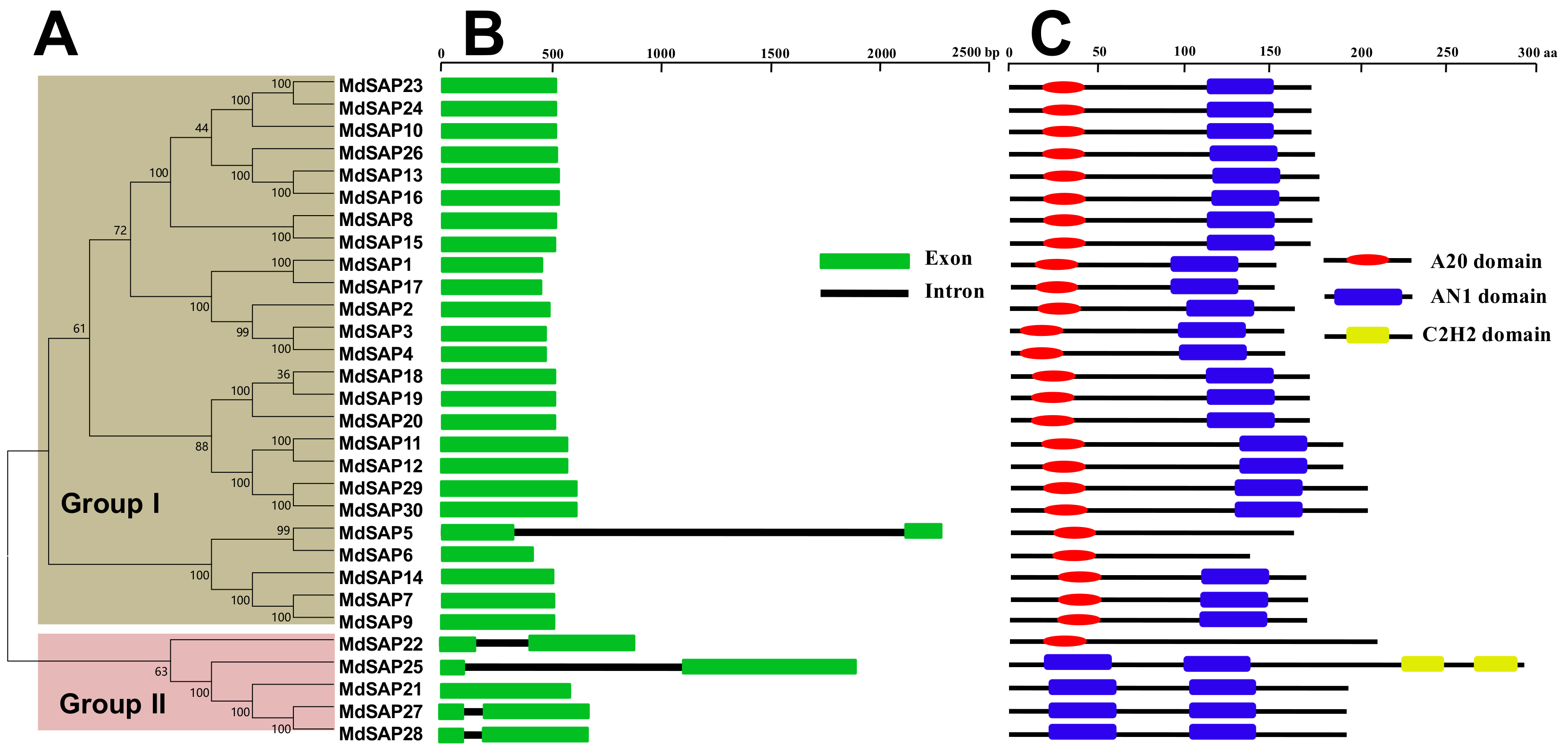
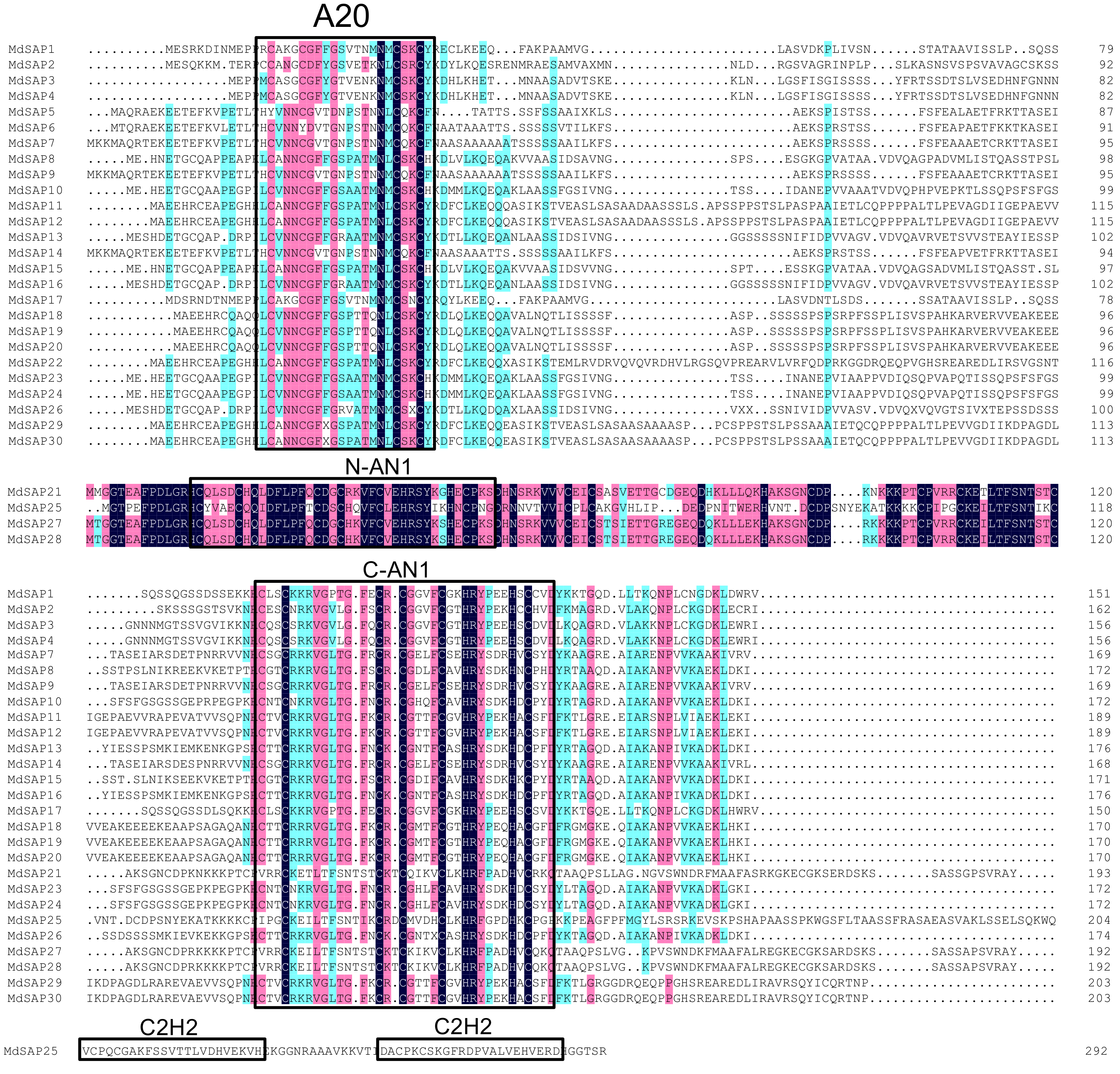
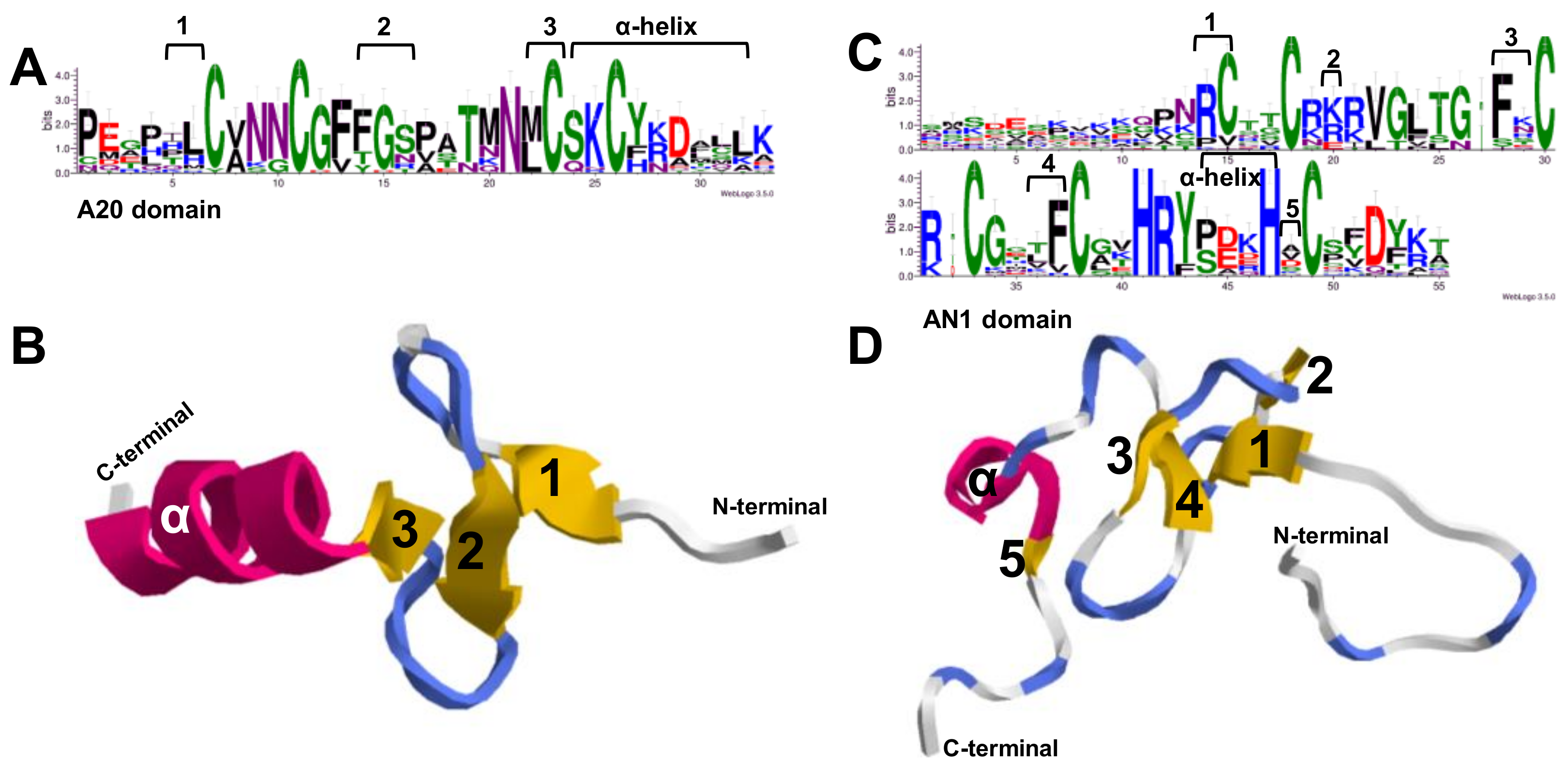
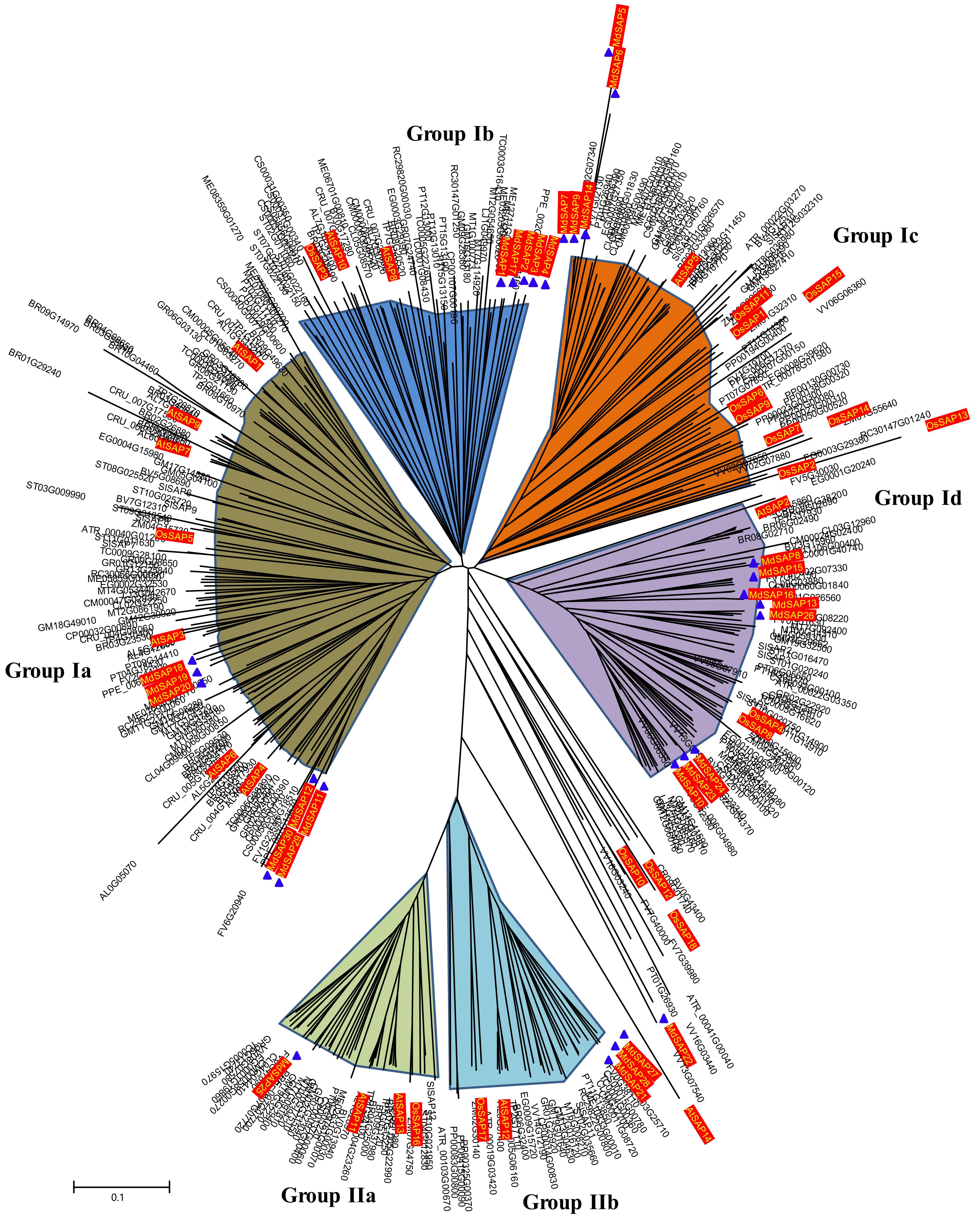
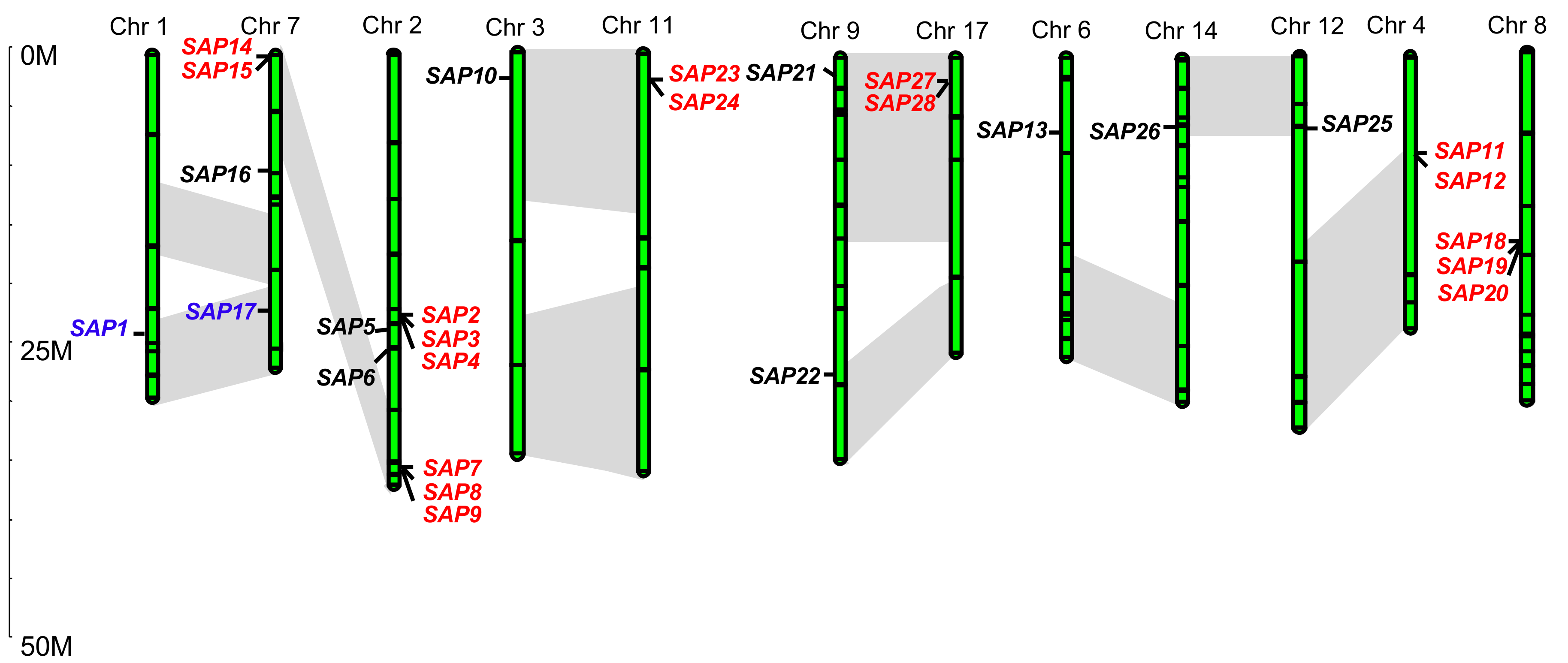
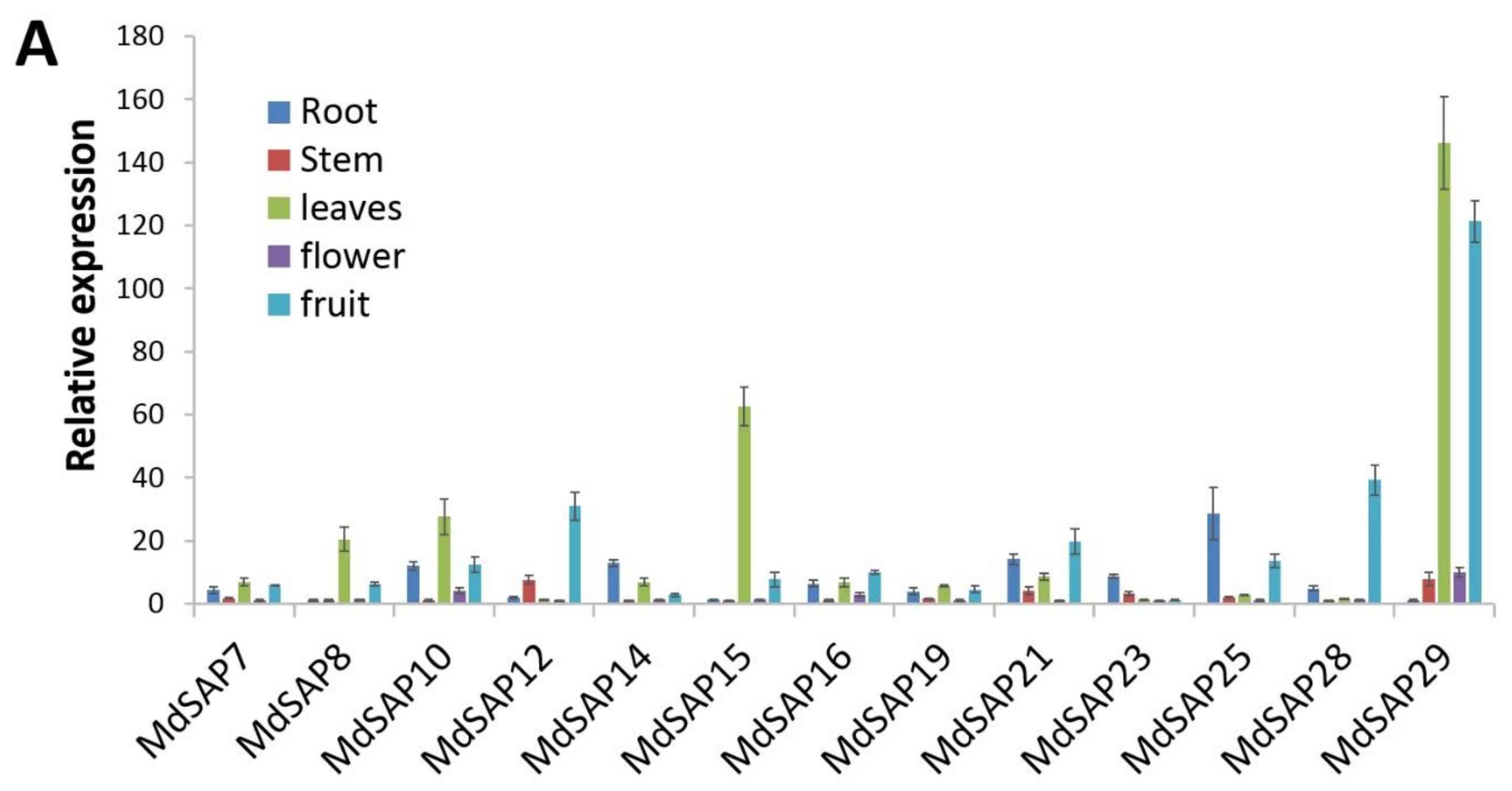
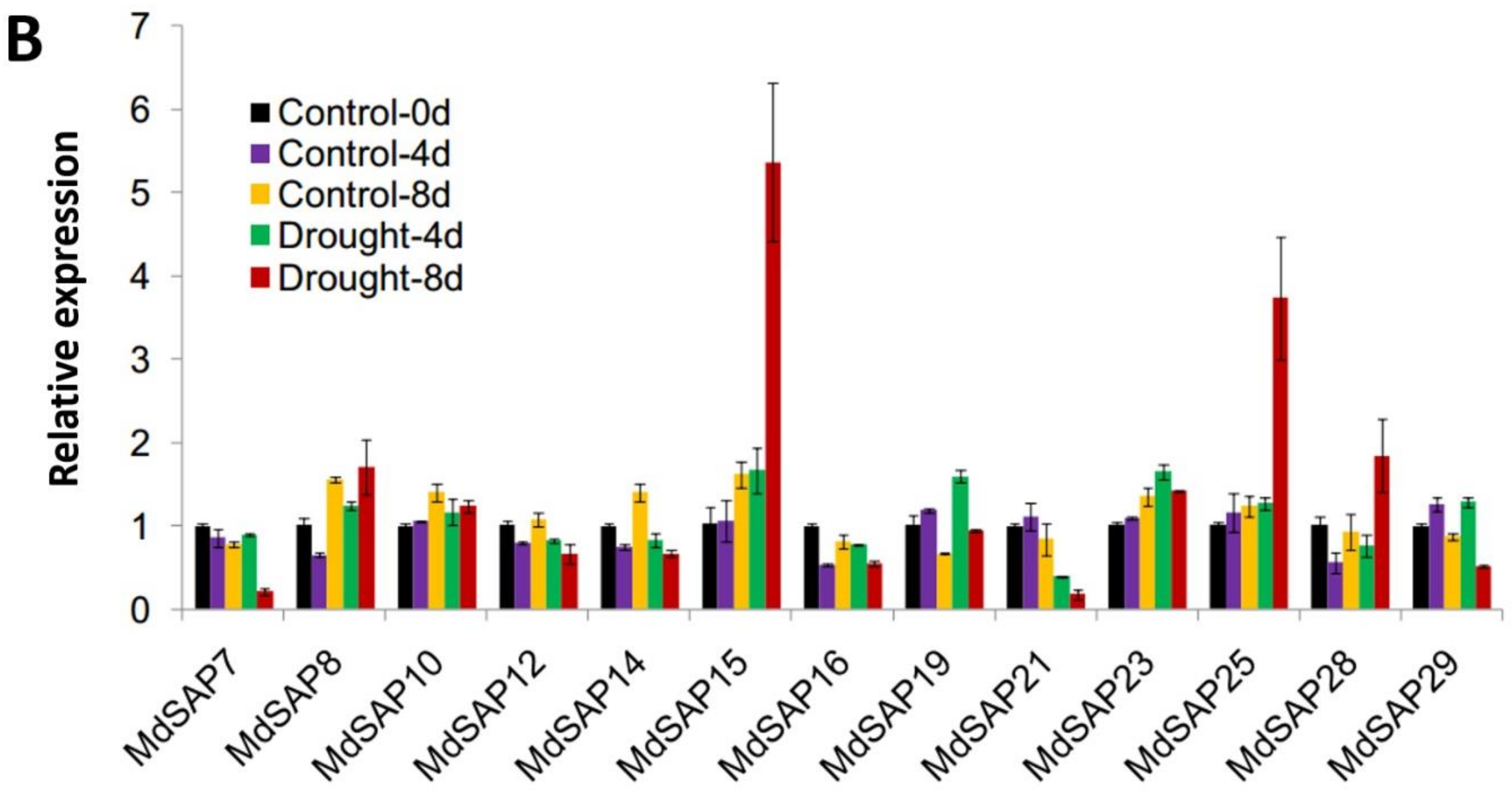
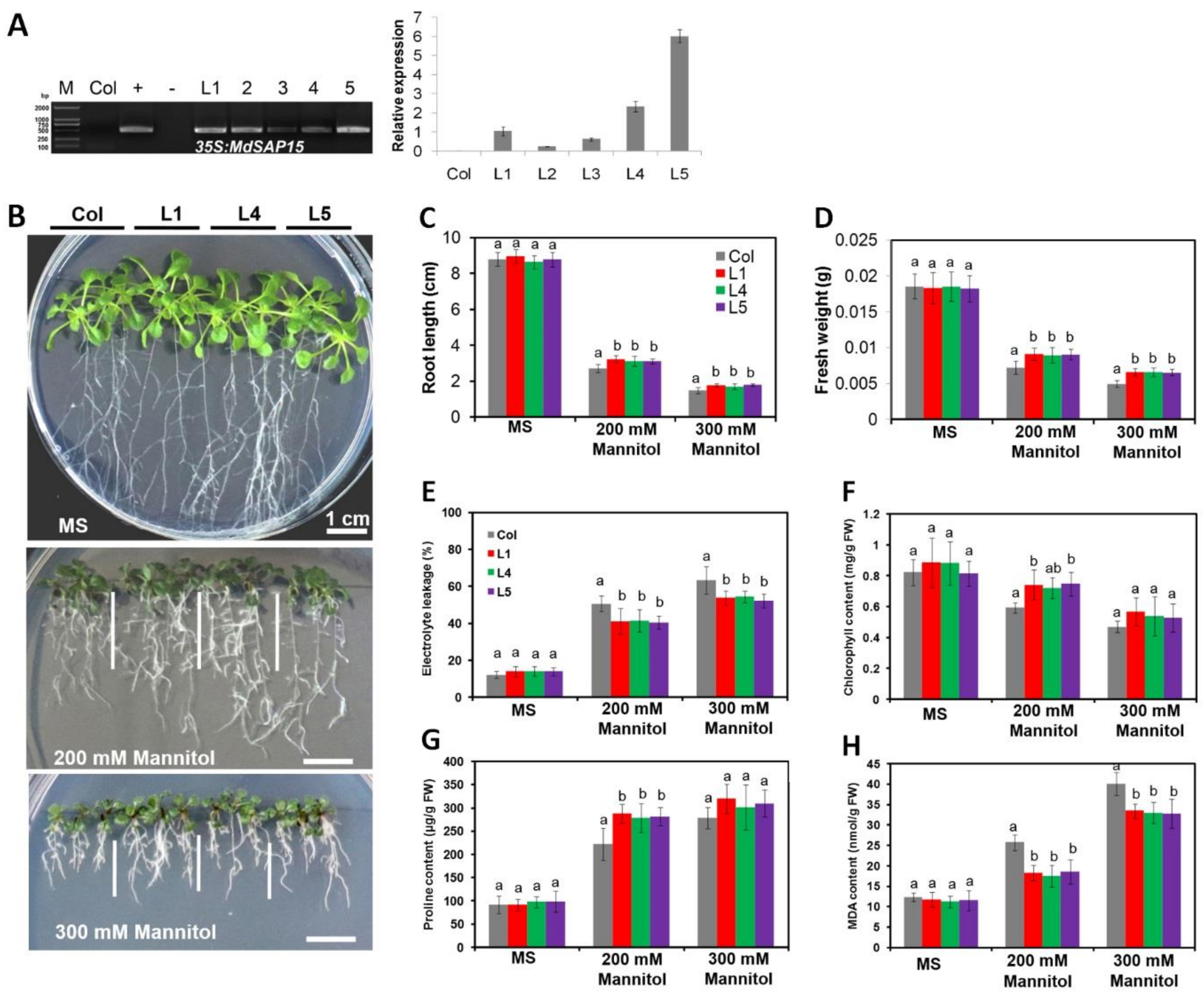

| Gene Name | Gene ID 1 | Zinc Finger Domain | Protein Length (aa) | Molecular Weight (kDa) | Theoretical Isoeletrical Point | Chromosome Location |
|---|---|---|---|---|---|---|
| MdSAP1 | MDP0000494946 | A20-AN1 | 151 | 16.53 | 8.41 | chr1:24227744..24228199 |
| MdSAP2 | MDP0000588934 | A20-AN1 | 162 | 17.71 | 8.62 | chr2:22718230..22718718 |
| MdSAP3 | MDP0000122842 | A20-AN1 | 156 | 17.07 | 8.27 | chr2:22745813..22746283 |
| MdSAP4 | MDP0000237812 | A20-AN1 | 156 | 17.07 | 8.27 | chr2:22753663..22754133 |
| MdSAP5 | MDP0000316313 | A20 | 161 | 18.11 | 8.95 | chr2:24190887..24193156 |
| MdSAP6 | MDP0000543745 | A20 | 136 | 15.18 | 6.37 | chr2:25865864..25866277 |
| MdSAP7 | MDP0000362676 | A20-AN1 | 169 | 18.42 | 9.05 | chr2:35848074..35848583 |
| MdSAP8 | MDP0000874708 | A20-AN1 | 172 | 18.24 | 8.12 | chr2:35871562..35872080 |
| MdSAP9 | MDP0000362677 | A20-AN1 | 169 | 18.42 | 9.05 | chr2:35878425..35878935 |
| MdSAP10 | MDP0000164222 | A20-AN1 | 172 | 18.41 | 7.52 | chr3:2250369..2250887 |
| MdSAP11 | MDP0000516205 | A20-AN1 | 189 | 20.09 | 6.78 | chr4:8801881..8802450 |
| MdSAP12 | MDP0000506127 | A20-AN1 | 189 | 20.09 | 6.78 | chr4:8807038..8807607 |
| MdSAP13 | MDP0000286185 | A20-AN1 | 176 | 18.97 | 7.46 | chr6:7080970..7081500 |
| MdSAP14 | MDP0000263150 | A20-AN1 | 168 | 18.51 | 9.16 | chr7:613109..613615 |
| MdSAP15 | MDP0000292844 | A20-AN1 | 171 | 18.17 | 8.12 | chr7:697510..698025 |
| MdSAP16 | MDP0000294781 | A20-AN1 | 176 | 18.97 | 7.46 | chr7:10610840..10611370 |
| MdSAP17 | MDP0000133254 | A20-AN1 | 150 | 16.41 | 8.41 | chr7:22721788..22722240 |
| MdSAP18 | MDP0000139359 | A20-AN1 | 170 | 18.59 | 8.67 | chr8:16795514..16796026 |
| MdSAP19 | MDP0000707978 | A20-AN1 | 170 | 18.59 | 8.67 | chr8:16801945..16802457 |
| MdSAP20 | MDP0000296953 | A20-AN1 | 170 | 18.59 | 8.67 | chr8:16804379..16804891 |
| MdSAP21 | MDP0000211516 | AN1-AN1 | 193 | 21.36 | 8.67 | chr9:2267267..2267848 |
| MdSAP22 | MDP0000165407 | A20 | 209 | 23.09 | 8.29 | chr9:27693011..27693884 |
| MdSAP23 | MDP0000231017 | A20-AN1 | 172 | 18.18 | 7.51 | chr11:2865175..2865693 |
| MdSAP24 | MDP0000683912 | A20-AN1 | 172 | 18.18 | 7.51 | chr11:2875969..2876487 |
| MdSAP25 | MDP0000652898 | AN1-AN1-C2H2-C2H2 | 293 | 32.04 | 8.26 | chr12:7214047..7215925 |
| MdSAP26 | MDP0000086327 | A20-AN1 | 174 | 18.78 | 7.46 | chr14:7829264..7829785 |
| MdSAP27 | MDP0000141121 | AN1-AN1 | 192 | 21.39 | 8.72 | chr17:2716099..2716758 |
| MdSAP28 | MDP0000853499 | AN1-AN1 | 192 | 21.39 | 8.72 | chr17:2716210..2716869 |
| MdSAP29 | MDP0000661416 | A20-AN1 | 203 | 21.86 | 7.66 | unanchored:14381067..14381678 |
| MdSAP30 | MDP0000284856 | A20-AN1 | 203 | 21.86 | 7.66 | unanchored:14408647..14409258 |
| Cis-Acting Elements | ABRE | ARE | CGTCA | ERE | HSE | LTR | MBS | TCA | TC-Rich Repeat | W-Box |
|---|---|---|---|---|---|---|---|---|---|---|
| Stress to Response | ABA | Hypoxia | MeJA | Ethylene | Heat | Chilling | Drought | SA | Defense | Pathogen |
| MdSAP7 | 2/2 | 2/0 | 2/2 | 1/0 | 1/1 | 0/2 | 0/2 | |||
| MdSAP8 | 0/1 | 0/1 | 3/0 | 0/3 | 0/1 | |||||
| MdSAP10 | 2/0 | 0/2 | 0/1 | 1/0 | 0/2 | |||||
| MdSAP12 | 1/0 | 1/0 | ||||||||
| MdSAP14 | 2/0 | 1/1 | 2/0 | 1/0 | 1/0 | 1/0 | 0/1 | |||
| MdSAP15 | 0/1 | 0/2 | 0/1 | 0/1 | 0/1 | 1/0 | 1/0 | |||
| MdSAP16 | 2/2 | 2/0 | 1/0 | 3/0 | ||||||
| MdSAP19 | 0/2 | 0/1 | 1/1 | 1/1 | 2/0 | |||||
| MdSAP21 | 1/0 | 1/0 | 1/2 | 1/0 | ||||||
| MdSAP23 | 1/0 | 1/4 | 0/2 | 1/0 | 1/0 | |||||
| MdSAP25 | 1/1 | 1/1 | 1/1 | 0/2 | 1/1 | 0/1 | 0/1 | |||
| MdSAP28 | 0/4 | 1/2 | 1/1 | 1/1 | 1/1 | |||||
| MdSAP29 | 0/2 | 1/2 | 1/1 | 1/1 | 1/0 | 2/0 |
| Plant Species | A20- | A20- | A20 | AN1 | AN1- | AN1- | AN1- | Total Number |
|---|---|---|---|---|---|---|---|---|
| AN1 | A20- | AN1 | AN1- | AN1- | ||||
| AN1 | C2H2 | C2H2- | ||||||
| C2H2 | ||||||||
| Malus domestica | 23 | 0 | 3 | 0 | 3 | 0 | 1 | 30 |
| Arabidopsis thaliana | 10 | 0 | 0 | 1 | 1 | 1 | 1 | 14 |
| Oryza sativa | 11 | 1 | 1 | 3 | 1 | 0 | 1 | 18 |
| Populus trichocarpa | 15 | 0 | 0 | 2 | 1 | 0 | 1 | 19 |
| Solanum lycopersicum | 9 | 0 | 0 | 1 | 2 | 0 | 1 | 13 |
| Gossypium hirsutum | 14 | 0 | 0 | 2 | 2 | 0 | 1 | 19 |
| Populus euphratica | 15 | 0 | 0 | 0 | 2 | 0 | 1 | 18 |
| Arabidopsis lyrata | 12 | 0 | 0 | 0 | 1 | 1 | 1 | 15 |
| Amborella trichopoda | 3 | 0 | 1 | 1 | 1 | 0 | 1 | 7 |
| Brassica rapa | 18 | 0 | 1 | 5 | 1 | 2 | 1 | 28 |
| Beta vulgaris | 6 | 0 | 0 | 1 | 0 | 0 | 1 | 8 |
| Citrullus lanatus | 7 | 0 | 0 | 2 | 1 | 0 | 1 | 11 |
| Cucumis melo | 10 | 0 | 0 | 0 | 1 | 0 | 1 | 12 |
| Carica papaya | 5 | 0 | 0 | 0 | 1 | 0 | 1 | 7 |
| Chlamydomonas reinhardtii | 1 | 0 | 0 | 1 | 0 | 0 | 0 | 2 |
| Capsella rubella | 10 | 0 | 0 | 0 | 1 | 1 | 1 | 13 |
| Citrus sinensis | 10 | 0 | 0 | 0 | 1 | 0 | 1 | 12 |
| Eucalyptus grandis | 8 | 1 | 0 | 1 | 1 | 0 | 0 | 11 |
| Fragaria vesca | 12 | 0 | 0 | 1 | 1 | 0 | 1 | 15 |
| Glycine max | 18 | 0 | 0 | 2 | 2 | 0 | 4 | 26 |
| Gossypium raimondii | 14 | 0 | 0 | 2 | 1 | 0 | 2 | 19 |
| Lotus japonicus | 4 | 0 | 0 | 1 | 1 | 0 | 0 | 6 |
| Manihot esculenta | 14 | 0 | 0 | 1 | 1 | 0 | 1 | 17 |
| Medicago truncatula | 11 | 0 | 0 | 2 | 1 | 0 | 2 | 16 |
| Physcomitrella patens | 6 | 0 | 0 | 1 | 2 | 0 | 1 | 10 |
| Prunus persica | 8 | 0 | 0 | 0 | 1 | 0 | 2 | 11 |
| Ricinus communis | 5 | 0 | 0 | 2 | 1 | 0 | 1 | 9 |
| Solanum tuberosum | 13 | 0 | 0 | 3 | 1 | 0 | 2 | 19 |
| Theobroma cacao | 10 | 0 | 0 | 0 | 1 | 0 | 1 | 12 |
| Thellungiella parvula | 11 | 0 | 0 | 0 | 1 | 1 | 1 | 14 |
| Vitis vinifera | 4 | 0 | 1 | 4 | 2 | 0 | 0 | 11 |
| Zea mays | 8 | 0 | 0 | 1 | 1 | 0 | 1 | 11 |
| Group | Ia | Ib | Ic | Id | IIa | IIb |
|---|---|---|---|---|---|---|
| Intronless number | 105 | 43 | 63 | 61 | 1 | 5 |
| Total number | 123 | 53 | 74 | 78 | 39 | 34 |
| Percentage (%) | 85.36 | 81.13 | 85.13 | 78.2 | 2.56 | 14.7 |
| Use | Primer Name | Forward Primer (5′–3′) | Reverse Primer (5′–3′) |
|---|---|---|---|
| Complete | MdSAP7 | ATGAAAAAAATGGCACAGAGAA | TCAAACCCGGACGATCTTTGCGG |
| ORF | MdSAP8 | ATGGAGCACAATGAGACAGGAT | TCAGATTTTATCCAGCTTTTCT |
| amplification | MdSAP10 | ATGGAGCACGAGGAGACTGGATG | TTAGATTTTATCGAGCTTCTCA |
| MdSAP12 | ATGGCGGAAGAGCACAGATGCG | TCAAATCTTCTCGAGCTTCTCG | |
| MdSAP14 | ATGAAAAAAATGGCACAGAGAA | TCAGAGCCGGACGATCTTCGCA | |
| MdSAP15 | ATGGAGCACAATGAGACAGGATG | TCAGATTTTATCCAGCTTGTCTG | |
| MdSAP16 | ATGGAATCTCATGATGAAACTG | CTAGATTTTGTCAAGTTTGTCTG | |
| MdSAP19 | ATGGCGGAAGAGCATCGTTGCCA | TCAAATCTTATGCAGCTTCTCCG | |
| MdSAP21 | ATGATGGGAGGAACAGAAGCTT | TCAATACGCTCGAACAGATGGCC | |
| MdSAP23 | ATGGAGCACGAGGAGACTGGATG | TTAGATTTTACCAAGCTTGTCAG | |
| MdSAP25 | ATGGGAACTCCGGAATTCCCAGA | CTATGCTCTTGAAGTACCGCCGT | |
| MdSAP28 | ATGACGGGAGGAACAGAAGCTTT | TCAATAAGCTCGAACAGAAGGC | |
| MdSAP29 | ATGGCGGAAGAGCACAGATGCGA | TCACGGATTTGTACGTTGGCAA | |
| Promoter | MdSAP7 | CAGATTTTGTTCAAATGTAGG | TGGGCGATGGAGGAGACAGAAAT |
| amplification | MdSAP8 | TGTTTCAATTGCGTTCTTGAGG | CATTGTAATTCGCTTAAGTTCT |
| MdSAP10 | ACCTTTTCCAAAACCGTTATTAG | TGCGAAAACCAACAATTAATGG | |
| MdSAP12 | |||
| MdSAP14 | GTAAAGAGGTTAGTGGCCCTGAA | CAAATTCTGATCGATCGATCGAT | |
| MdSAP15 | ATGCGCTTTACTGTTTTTTCAGT | CATTGTAATTCGCTAAGTCCTT | |
| MdSAP16 | CACGAGGAGAGCACTAAAATGGA | CACCAAGAAAACCTCGCCGTTT | |
| MdSAP19 | ACCTTTCTTTTGAGAAGTTTGT | TGCAATTCCAAAACAAATTATTC | |
| MdSAP21 | ATGGATTCTAGTTTGATTTGGGC | GATTTTTCAGTTTGTTAAATTTT | |
| MdSAP23 | ATATTTCCATCACATTGAATAA | CTACTCAGCTTACCTGCAAAGAG | |
| MdSAP25 | GCAGGTAGAGTTTCAAAGTACG | AAATTTTGTATGTACAACACTA | |
| MdSAP28 | ACAGGTCACCGTGGTGACTCCGG | GTCGGTCGGTCGGTCTGGGGTTG | |
| MdSAP29 | GTGCTTTTTGTTGGAACACAAAG | CGATCGAGAGGACAAAAATATTA | |
| qRT-PCR | MdSAP7 | TCGTCCGGGTTTGATGATTT | TCCCCGGTCTCTGAATTTCG |
| MdSAP8 | GGGAAGCGGATAGGAACCAT | CTTGGGAGCTTCAGGAGGAG | |
| MdSAP10 | GATTATCGCACTGCTGGACG | AGTGCTAAGATACCGCTGCA | |
| MdSAP12 | GTTGGTCATAGCCGAGAAGC | ATCAGCTTAATTCCCACGCG | |
| MdSAP14 | GCTCTGACCGGTTTGACAAT | TTGCTGATGATCTCCGGGAG | |
| MdSAP15 | ATGATTACCGGACTGCTGCT | CCACATGGGTAGAAATGAGAGC | |
| MdSAP16 | GCCAATCCTATCGTGAAGGC | GAGACCTATGCAGACAAGAAGC | |
| MdSAP19 | CGATTTCAGAGGGATGGGGA | CAACCATCCCCTACCCCAAT | |
| MdSAP21 | AGGGAAAGAATGCGGGAAGA | CGAAGAAACATGAAACTGCGG | |
| MdSAP23 | GCCAACCCTGTCGTAAAAGC | TGCTAAGATACCGCTGCAGA | |
| MdSAP25 | AATCCAATCCAAGCCTCGGA | TCCCATCCGAATTTTGCACG | |
| MdSAP28 | TGCTTTGAGGGAAGGGAAAGA | ACATCGAATTGTGGAAGCAGA | |
| MdSAP29 | TTCCTCCTCGCACAGATCAG | TCCGCCATGTCTACAGTCAA | |
| MdMDH | CGTGATTGGGTACTTGGAAC | TGGCAAGTGACTGGGAATGA | |
| pRI-101AN | MdSAP15 | TTGATACATATGCCCGTCGACATGGAGCACAAT | AGAGTTGTTGATTCAGGATCCTCAGATTTTATC |
| 35S | CGCACAATCCCACTATCCTT | ||
| qRT-MdSAP15 | AGTCGTTGCAGCATCCATTG | GGAAGCCTGTGTTGAGATAAGC | |
| AtActin2 | GTGAAGGCTGGATTTGCAGGA | AACCTCCGATCCAGACACTGT |
© 2018 by the authors. Licensee MDPI, Basel, Switzerland. This article is an open access article distributed under the terms and conditions of the Creative Commons Attribution (CC BY) license (http://creativecommons.org/licenses/by/4.0/).
Share and Cite
Dong, Q.; Duan, D.; Zhao, S.; Xu, B.; Luo, J.; Wang, Q.; Huang, D.; Liu, C.; Li, C.; Gong, X.; et al. Genome-Wide Analysis and Cloning of the Apple Stress-Associated Protein Gene Family Reveals MdSAP15, Which Confers Tolerance to Drought and Osmotic Stresses in Transgenic Arabidopsis. Int. J. Mol. Sci. 2018, 19, 2478. https://doi.org/10.3390/ijms19092478
Dong Q, Duan D, Zhao S, Xu B, Luo J, Wang Q, Huang D, Liu C, Li C, Gong X, et al. Genome-Wide Analysis and Cloning of the Apple Stress-Associated Protein Gene Family Reveals MdSAP15, Which Confers Tolerance to Drought and Osmotic Stresses in Transgenic Arabidopsis. International Journal of Molecular Sciences. 2018; 19(9):2478. https://doi.org/10.3390/ijms19092478
Chicago/Turabian StyleDong, Qinglong, Dingyue Duan, Shuang Zhao, Bingyao Xu, Jiawei Luo, Qian Wang, Dong Huang, Changhai Liu, Chao Li, Xiaoqing Gong, and et al. 2018. "Genome-Wide Analysis and Cloning of the Apple Stress-Associated Protein Gene Family Reveals MdSAP15, Which Confers Tolerance to Drought and Osmotic Stresses in Transgenic Arabidopsis" International Journal of Molecular Sciences 19, no. 9: 2478. https://doi.org/10.3390/ijms19092478
APA StyleDong, Q., Duan, D., Zhao, S., Xu, B., Luo, J., Wang, Q., Huang, D., Liu, C., Li, C., Gong, X., Mao, K., & Ma, F. (2018). Genome-Wide Analysis and Cloning of the Apple Stress-Associated Protein Gene Family Reveals MdSAP15, Which Confers Tolerance to Drought and Osmotic Stresses in Transgenic Arabidopsis. International Journal of Molecular Sciences, 19(9), 2478. https://doi.org/10.3390/ijms19092478





